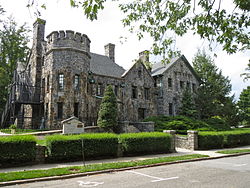
Asheville is a city in and the county seat of Buncombe County, North Carolina, United States. Located at the confluence of the French Broad and Swannanoa rivers, it is the most populous city in Western North Carolina, and the state's 11th-most-populous city. According to the 2020 census, the city's population was 94,589, up from 83,393 in the 2010 census. It is the principal city in the three-county Asheville metropolitan area, which had an estimated population of 417,202 in 2023.
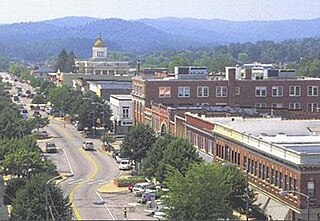
Hendersonville is a city in and the county seat of Henderson County, North Carolina, United States, located 22 miles (35 km) south of Asheville. Like the county, the city is named for 19th-century North Carolina Supreme Court Chief Justice Leonard Henderson.

Fisher Park is a neighborhood in the north central section of the United States city of Greensboro, North Carolina. Captain Basil J. Fisher turned a swamp into Greensboro's most fashionable Gilded Era address in 1901 when he donated the lowlands for a city park that bears his name. Residents took full advantage of ample lots overlooking the park by commissioning the city's best architects to design sometimes palatial homes. The neighborhood is recognized as Greensboro's first suburb, and is the city's most popular historic district.

Lillian Exum Clement, later known as Lillian Stafford, was an American politician who was the first woman elected to the North Carolina General Assembly and the first woman to serve in any state legislature in the Southern United States.

Elmwood Park is a residential neighborhood and historic district in what is now the center of Columbia, South Carolina. Founded in the early 1900s, it was added to the National Register of Historic Places as Elmwood Park Historic District in 1991.

The Thomas Wolfe House, also known as the Thomas Wolfe Memorial, is a state historic site, historic house and museum located at 52 North Market Street in downtown Asheville, North Carolina. The American author Thomas Wolfe (1900–1938) lived in the home during his boyhood. The house was designated a National Historic Landmark in 1971 for its association with Wolfe. It is located in the Downtown Asheville Historic District.

The Drake Park Neighborhood Historic District is located adjacent to Drake Park near the historic downtown area in Bend, Oregon, United States. Because of the unique and varied architecture in the Drake Park neighborhood and its close association with the early development of the city of Bend, the area was listed on the National Register of Historic Places in 2005.
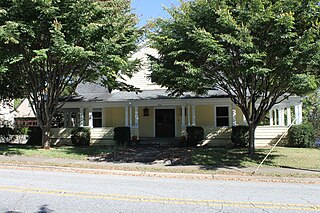
The Edgar Allan Poe House is a historic home located in Caldwell County at 506 Main Street NW in Lenoir, North Carolina.

Boylan Heights is one of eight historic neighborhoods surrounding downtown Raleigh, North Carolina. Developed in the early 20th century it was one of the earliest planned suburbs in the city. From its apex at Montfort Hall, the neighborhood slops gradually south-east towards Western Boulevard. After petitions from residents, the neighborhood was added to the National Register of Historic Places as a historic district on July 29, 1985.

George Willis Pack was an American philanthropist, lumberman, and railroad president. Building on his father's legacy in the Lower Peninsula of Michigan, Pack successfully developed many timber businesses and became one of Michigan's first millionaires. He was also a leading citizen of Cleveland, Ohio, and a noted resident and benefactor of Asheville, North Carolina. He donated five properties to the City of Asheville, including a school, a library, public parks, and land for the county's courthouse. In 1960, the Asheville Citizen-Times called him "Asheville's greatest benefactor."

The Battery Heights Historic District is a historic neighborhood and national historic district located southeast of downtown Raleigh, North Carolina, USA. Named for the earthen batteries stationed in the area during the Civil War, the neighborhood has a suburban character, despite its close proximity to the city center.
Richard Sharp Smith was an English-born American architect, noted for his association with George W. Vanderbilt's Biltmore Estate and Asheville, North Carolina. Smith worked for some of America's important architectural firms of the late 19th century—Richard Morris Hunt, Bradford Lee Gilbert, and Reid & Reid—before establishing his practice in Asheville. His most significant body of work is in Asheville and Western North Carolina, including dozens of buildings that are listed on the National Register of Historic Places or are contributing structures to National Register Historic Districts.
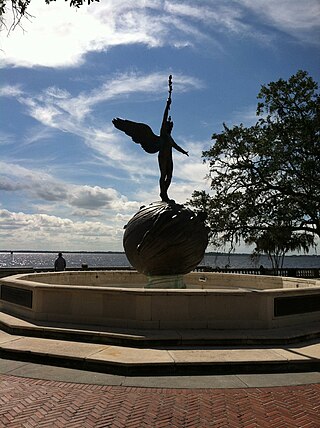
Riverside and Avondale are two adjacent and closely associated neighborhoods, alternatively considered one continuous neighborhood, of Jacksonville, Florida. The area is primarily residential, but includes some commercial districts, including Five Points, the King Street District, and the Shoppes of Avondale.
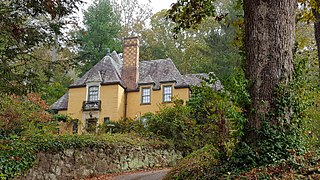
Grove Park Historic District is a national historic district located at Asheville, Buncombe County, North Carolina. The district encompasses 290 contributing buildings and 1 contributing site in a predominantly residential section Asheville. The planned suburban community was originally platted and developed in 1908-1913 and 1914. It includes representative examples of Colonial Revival, Tudor Revival, and Bungalow style dwellings. The community was laid out by noted landscape architect Chauncey Beadle. The Kimberly Amendment to Grove Park was an expansion made to the original Grove Park development in 1923. It includes the former Asheville Country Club, now the Grove Park Inn Country Club.

Proximity Park Historic District is a national historic district located at Asheville, Buncombe County, North Carolina. The district encompasses 62 contributing buildings and 1 contributing site in a predominantly residential section of Asheville. The district was largely developed in early-20th century, and includes representative examples of Colonial Revival, Mission Revival, and Bungalow style dwellings. Located in the district is the separately listed St. Mary's Church (1914) and rectory (1923) designed by architect Richard Sharp Smith.
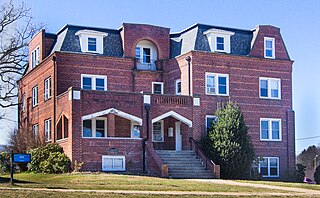
Eliada Home is a national historic district located near Asheville, Buncombe County, North Carolina. The district originally encompassed 10 contributing buildings and 3 contributing sites associated with a youth home complex in suburban Asheville. Of the original 10, only 5 remain. They included the early residential, administrative, and agricultural buildings of the home as well as a residence, a tabernacle site, a log guest cabin, and a cemetery. The primary buildings were the Main Building and the Allred Cottage (1930). The buildings included representative examples of the Colonial Revival, Bungalow, Bungalow/craftsman, and Tudor Revival styles.
Downtown Asheville Historic District is a national historic district located at Asheville, Buncombe County, North Carolina. The district encompasses about 279 contributing buildings and one contributing object in the central business district of Asheville. It includes commercial, institutional, and residential buildings in a variety of popular architectural styles including Colonial Revival, Queen Anne, and Art Deco.
Snow Hill Historic District is a national historic district located at Snow Hill, Greene County, North Carolina. The district encompasses 229 contributing buildings, a contributing site, two contributing structures, and a contributing object in the central business district and surrounding residential sections of Snow Hill. The buildings are in a variety of popular 19th and early-20th century architectural styles including Greek Revival, Gothic Revival, Colonial Revival, and, Bungalow / American Craftsman. Located in the district are the separately listed Greene County Courthouse and St. Barnabas Episcopal Church. Other notable buildings include J. Exum & Co. Grocery building, Harper Drugstore, Sugg-Harper House, Williams-Exum Housem, Murphrey-Morrill House (1885), Josiah Exum House (1887-1888), Alfred Warren House (1912-1915), Calvary Memorial Methodist Church (1928), Snow Hill Presbyterian Church (1935), and former First Baptist Church.

James Madison and Leah Arcouet Chiles House is an historic home located in Asheville, Buncombe County, North Carolina. It is a two-story Spanish Colonial Revival-style villa located at 21 Chiles Avenue in the Kenilworth neighborhood of Asheville. James "Jake" Chiles, a successful businessman and real estate developer and his wife, Leah. Chiles engaged local architect Ronald Greene to design the house, which was constructed between 1922 and 1925. The stuccoed dwelling has a low-pitched hip roof covered with clay tile, walled courtyards, private balconies, and a Baroque-inspired entrance bay. The interior features oak floors, black walnut paneling, round-arch double- leaf wooden patio doors, and colorful glazed-tile bathrooms. James Madison and Leah Arcouet Chiles developed Kenilworth as a residential suburb in the 1910s around the rebuilt Kenilworth Inn, which was completed in 1918.

Kate and Charles Noel Vance House is a mansion located in Black Mountain, Buncombe County, North Carolina. It was listed on the National Register of Historic Places in 2016.
